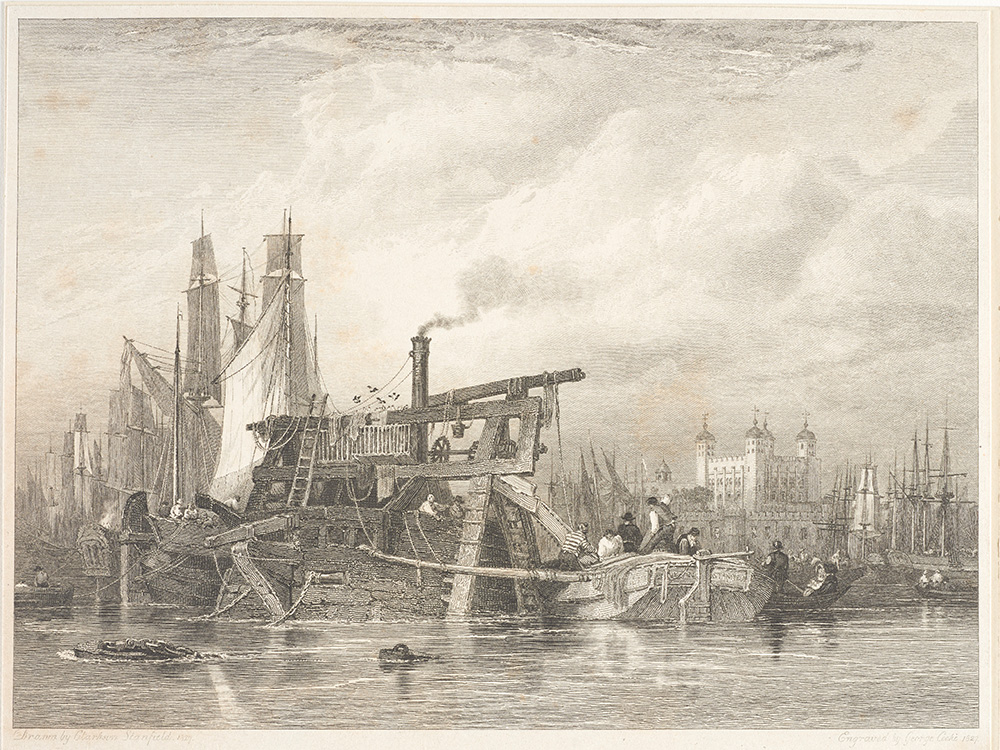A necessary burden.
Text: Noëmi Kern
Sometimes, the word “ballast” has a negative connotation of “burden”. Yet, ballast was a crucial resource in global seafaring.
Gravel, sand, rocks and coal: From the second half of the 19th century, these materials traveled the world’s oceans by the ton. Their weight was used to lower and optimize the center of mass on ships so that they would remain stable on the high seas and ensure a safe voyage.
This “ballast” couldn’t be too expensive. Ships were loaded with ballast when there were no goods to transport, or to reduce the overall value of their cargo and the financial loss in the event of an accident.
Ships carrying voluminous but lightweight goods such as tea or cotton also needed additional weight to improve their stability. Various materials could be used, so the most suitable had to be identified. If weight was the main requirement but space was at a premium, then metal was an option – whether scrap iron or metal bars produced specifically for this purpose.
The drawback was that iron rusted over time. Sand was particularly cheap, but it absorbed moisture and got into every crack and crevice. “Choosing a type of ballast was a matter of finding a compromise between function, materiality and value,” says Paul Blickle, a historian at the Institute for European Global Studies, University of Basel. Blickle’s doctoral dissertation focuses on these “goods that aren’t goods,” as he puts it. Ballast was a means to an end and fulfilled its purpose only in transit.
These days, the word “ballast” has negative connotations in the German language; it also means “burden” or “baggage”. Blickle sees things differently: “Ballast may have been cumbersome, but it certainly wasn’t useless or superfluous – quite the opposite.” He aims to figure out how ballast influenced maritime connections in the 19th century and how it changed the quality of transit at sea. He is particularly interested in moments when people came into personal contact with ballast.
With shovels and brawn.
One group were the port workers who loaded the ships with the right amount of ballast. In the 19th century, a medium-sized merchant ship needed several hundred tons of ballast if it was going to leave the port without any cargo. Although large ports were becoming increasingly mechanized, loading a ship with ballast required hard manual labor by “ballast heavers”. These were unskilled laborers who had very few other ways of earning money and were generally badly paid.
To make the public aware of their precarious situation, London workers launched an information campaign in the early 1850s. “A strike probably wouldn’t have achieved much; they would simply have been replaced with other workers. However, the public pressure led to a parliamentary intervention aimed at improving the workers’ situation. They were made permanent employees of the London ballast monopoly,” says Blickle.
Exploring the still little-researched social history of ballast, Blickle finds information in the records of parliamentary debates, legal texts, newspaper reports, correspondence, sailors’ memoirs and other documents. There are a great number of sources about Great Britain in particular: At that time, London was the largest port in Europe. Ships brought in food, colonial goods and raw materials such as wood and coal. The weight of the exported goods was much lower. Accordingly, it was important for sailors to be able to load their ships with ballast so that they could sail on even if there was no new cargo. This meant that a port had to be able to provide enough ballast to be attractive to incoming ships.
From ballast to commodity.
Many places had strict rules on who was allowed to trade in ballast, and state protectionism was rife. Ships’ masters were either prohibited from reselling ballast, or incurred high charges and were subject to stringent conditions. This boosted the popularity of ballast substitutes such as coal and bricks, and in extreme cases even ice, that could be turned into money at the end of the journey – if not to make a profit, then at least to cover costs.
As Blickle says, “On the one hand, ship owners had an incentive to have ballast on board that could be sold if necessary. On the other, commercial goods also had a weight and therefore played a role in stabilizing the ship. I want to challenge the binary division between commodities and ballast.”
In addition to the ballastmen in the harbor, sailors came into contact with ballast. Blickle wants to find out how often the men at sea had to deal with the ballast. As long as things were going well, it was simply a part of the cargo. But if the sea became rough, the crew would have to get their hands dirty and restow any ballast that had slipped out of place. When they reached their destination, they either had to get rid of the ballast or find more if they needed to adapt the amount to a new (lighter or heavier) consignment of cargo.
Ballast may well have also impacted health: “Sand can contain microorganisms that could have released diseases on board,” Blickle says. He is currently searching the sources for relevant information. Then, as now, global trade spread pathogens – as well as animals and plants – around the world.
Even today, ships need ballast, and since the early 20th century, seawater has become a free and universally available form of ballast. If required, ships can fill special tanks in a matter of hours, whereas loading a ship with ballast sand would have taken days or even weeks. Although its materiality has changed, the role of ballast remains the same, and ballast water can still carry (invasive) species.
More articles in this issue of UNI NOVA (November 2024).

